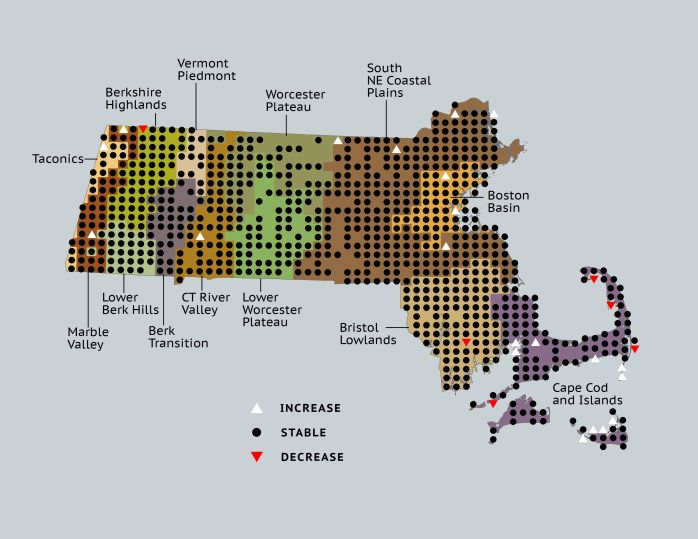Find a Bird
Red-winged Blackbird
Agelaius phoeniceus

Nearly ubiquitous and stable
Action/monitoring needed
“I value my garden more for being full of blackbirds than of cherries, and very frankly give them fruit for their songs.” – Joseph Addison, The Spectator
Many farmers probably would not agree with Mr. Addison on this point since Red-winged Blackbirds are infamous for feeding on field grain. Arguably, the most numerous native bird species in North America, the Red-winged Blackbird successfully dwells in marshes, fields, and a bevy of other habitats, and birders delight in the stunning red epaulets and easily recognized song of the male, both of which can be observed almost anywhere in the Commonwealth during the breeding season.
Historic Status
Henry M. Spelman of Cambridge reported in 1890 that a friend had witnessed a Red-winged Blackbird in Massachusetts in January, believing it to be the first-ever instance of the species overwintering in the state (Spelman 1890). Beyond that mention in the historical literature, little else is said about the Red-winged Blackbird’s status in the state other than that it has always been an abundant summer resident. Habitat change has probably affected its population, however, since it requires wetlands for breeding and farmland for foraging in the fall before migration. Also, blackbirds in general can be a scourge to farmers, and as such have long been subject to control measures.
Atlas 1 Distribution
Red-winged Blackbirds were all but ubiquitous in Atlas 1, were sixth in the race for getting reported from the most blocks, and were found in 94% of the blocks surveyed. So complete was their coverage of the western parts of the state that there were only 4 blocks west of the Connecticut River Valley that failed to report some evidence of nesting Red-winged Blackbirds. The Connecticut Valley itself had 95% block occupancy, with just 3 blocks totally devoid of blackbirds. The Worcester Plateau and Lower Worcester Plateau each had 7 unoccupied blocks, including a large chunk of open-water habitat in the Quabbin region. The bustling suburban and urban areas of the Coastal Plains and Boston Basin did not appear to impact the blackbirds in the least, with both regions being almost completely occupied. The Bristol/Narragansett Lowlands were similar, but the Cape and Islands had the lowest block occupancy of any region in the state at 87% – still a considerable presence of this nearly ubiquitous species.
Atlas 2 Distribution and Change
Continuing among the most widespread breeding birds in the Commonwealth, Red-winged Blackbirds were found in more than 96% of the blocks surveyed in Atlas 2, and rose to number 5 in the list of species occupying the most blocks. Because they are at near saturation in the state, there is no regional pattern for increase and decrease in block occupancy, and it is possible that some of the noted “declines” are really just misses in the field. The species is well established, and would seem not to be in any danger of declining, however, abundance estimates from the Breeding Bird Survey tell another story.
Atlas 1 Map

Atlas 2 Map

Atlas Change Map

Ecoregion Data
Atlas 1 | Atlas 2 | Change | ||||||
Ecoregion | # Blocks | % Blocks | % of Range | # Blocks | % Blocks | % of Range | Change in # Blocks | Change in % Blocks |
Taconic Mountains | 15 | 93.8 | 1.6 | 21 | 84.0 | 2.1 | 1 | 6.7 |
Marble Valleys/Housatonic Valley | 38 | 97.4 | 4.2 | 39 | 100.0 | 3.9 | 1 | 2.6 |
Berkshire Highlands | 54 | 98.2 | 5.9 | 54 | 98.2 | 5.4 | 0 | 0.0 |
Lower Berkshire Hills | 27 | 96.4 | 3.0 | 30 | 96.8 | 3.0 | 0 | 0.0 |
Vermont Piedmont | 17 | 100.0 | 1.9 | 17 | 100.0 | 1.7 | 0 | 0.0 |
Berkshire Transition | 38 | 100.0 | 4.2 | 40 | 100.0 | 4.0 | 0 | 0.0 |
Connecticut River Valley | 53 | 94.6 | 5.8 | 65 | 100.0 | 6.5 | 1 | 2.1 |
Worcester Plateau | 71 | 91.0 | 7.8 | 85 | 96.6 | 8.5 | 1 | 2.1 |
Lower Worcester Plateau | 67 | 90.5 | 7.4 | 78 | 97.5 | 7.8 | 0 | 0.0 |
S. New England Coastal Plains and Hills | 257 | 95.2 | 28.2 | 278 | 98.2 | 27.8 | 4 | 1.8 |
Boston Basin | 53 | 94.6 | 5.8 | 55 | 98.2 | 5.5 | 2 | 3.6 |
Bristol and Narragansett Lowlands | 103 | 97.2 | 11.3 | 108 | 94.7 | 10.8 | -1 | -1.0 |
Cape Cod and Islands | 118 | 86.8 | 13.0 | 131 | 91.0 | 13.1 | 6 | 5.0 |
Statewide Total | 911 | 94.0 | 100.0 | 1001 | 96.5 | 100.0 | 15 | 1.8 |
Notes
Despite this apparent growth, the Breeding Bird Survey (BBS) shows significant declines in the Red-winged Blackbird’s abundance for Massachusetts, the New England/Mid-Atlantic Region, and the Eastern US overall. It falls into our “whispering bird” category – those species with a demonstrated stable or increasing breeding footprint from Atlas 2 data, but also a demonstrated decline in abundance from the BBS. This drives our final assessment that this is a species with a need for further monitoring and conservation action.



